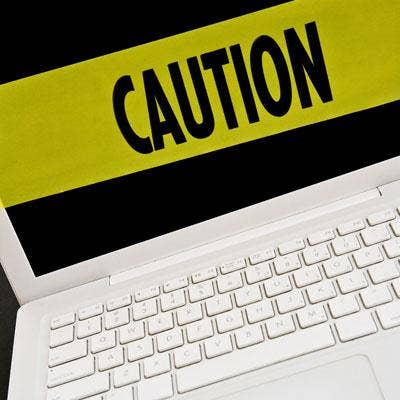5 Ways To Avoid An Epic Facebook Fail

Social Media Blunders Can Be Costly
Social media blunders can cause serious damage to a company or person's reputation. A simple mouse click could damage your character, which was the case with Montana Lt. Governor John Walsh. A reporter saw that Walsh apparently "liked" a Facebook page that featured pictures of women's breasts. The "like" was captured on a screenshot and widely published, damaging his campaign for Montana's U.S. Senate seat.
According to a Trend Micro survey, 26 percent of social media users have posted something they regret or have taken down. Experts say that taking a few precautionary measures could help protect your reputation. To help prevent an epic Facebook fail, CRN has come up with five ways to safeguard your privacy and security when using Facebook.

5. Failure To Reconsider Clicking That Link
Facebook scams spread quickly on the social network. A recent analysis conducted by security firm BitDefender found Facebook scams stealing account credentials, hijacking accounts and creating false "likes" to Facebook pages that the victim never intended to "like." A malicious script that spread in July enabled an attacker to complete a short but successful clickjacking campaign, tricking users into visiting a YouTube channel, a Facebook page and several website surveys. Other Facebook scams include links to third-party applications that promise too much functionality or posts with links to shocking videos or celebrity pictures.

4. Failure To Review Who You've Friended
Most security experts say that it is a good idea to conduct a regular review of all those who you have friended over the years. It may make sense to weed out former girlfriends or boyfriends, reconsider whether your boss or supervisor can view all your posts and reevaluate that friend request you accepted from your first grade pal. Unless you've made a conscious effort to open your life and your posts to the public, keeping the number of people you have friended to a minimum may help reduce the possibility of being socially engineered by a cybercriminal in the future.

3. Failure To Review Your Activity Log
The Facebook activity log gives users the ability to see everything they have done on the social network, from "liking" a Facebook page to commenting on a friend's timeline or posting a status update. From here, you can unlike or delete a post. It also tracks the Facebook apps used as well as the location of the device when logged into or out of Facebook. Does your activity log say you "like" something you don't? The log can provide clues into whether another person is using your account or if you have accessed an application that could damage your reputation. The Facebook log, rolled out last year, also tracks the searches made on the social network.

2. Failure To Select The Right Facebook Audience
Facebook provides an audience selector tool that is used when sharing status updates and other posts. The tool defaults to the audience that was used to share the previous post. Before posting, a good rule of thumb is to pause and review the content and confirm that the correct audience is selected. The tool is available in different areas on Facebook and updates itself for each post made. Facebook also warns users that when you post to another person's timeline, that person controls the audience that can view the post. Facebook said closely monitoring your timeline can also limit exposure to whatever your friends post to it. Trend Micro said that 36 percent of social media users say they have seen something inappropriate posted on a social network.

1. Failure To Check Privacy Settings
According to Trend Micro, 16 percent of Facebook users check their privacy settings each month. This is seriously disconcerting because security experts say privacy settings can change as new features are added to the platform. Facebook has a privacy shortcut tool at the top right of any Facebook page that gives users the ability to quickly adjust some of the most widely used privacy settings. More in-depth privacy settings can be found by clicking on the settings icon in the top right-hand corner of any Facebook page and selecting privacy settings from the drop-down menu. Knowing who can view and respond to your posts and photos is the first step in avoiding a costly mistake.